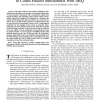Free Online Productivity Tools
i2Speak
i2Symbol
i2OCR
iTex2Img
iWeb2Print
iWeb2Shot
i2Type
iPdf2Split
iPdf2Merge
i2Bopomofo
i2Arabic
i2Style
i2Image
i2PDF
iLatex2Rtf
Sci2ools
TSP
2008
2008
Bit and Power Allocation for Goodput Optimization in Coded Parallel Subchannels With ARQ
Abstract--This paper addresses the problem of adaptively allocating the bits and the power among a set of parallel subchannels. A frame-oriented transmission with convolutional coding, hard Viterbi decoding, and automatic repeat request (ARQ) retransmission protocol is considered. The objective is to maximize the number of information bits delivered without error to the user by unit of time, or goodput. This criterion is a tradeoff between the bit rate and bit error probability criteria. First, a mathematical expression for the goodput of the system is presented. Then, using that expression, different bit and power allocation strategies are derived and compared. It turns out that having an equal bit error rate (BER) on each subchannel is near-optimal in terms of goodput. Finally, we prove that the waterfilling solution with adequate signal to noise ratio (SNR) gap value (or equivalently adequate target BER value) is near-optimal. We analytically show how this SNR gap value depends on t...
| Added | 16 Dec 2010 |
| Updated | 16 Dec 2010 |
| Type | Journal |
| Year | 2008 |
| Where | TSP |
| Authors | B. Devillers, Jérôme Louveaux, Luc Vandendorpe |
Comments (0)

